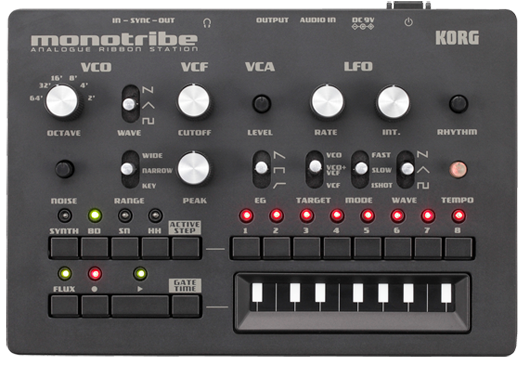Review: Monotribe V2
MSRP: $310, Korg Korg’s Monotribe unit is the big brother to the company’s succesful Monotron […]

MSRP: $310, Korg
Korg’s Monotribe unit is the big brother to the company’s succesful Monotron series, beefing up the pocket-sized analog synthesizer with a few extra features, a sequencer, and some actual knobs.
The Monotribe is still a relatively small unit (measuring roughly 6″x8″), but feels unexpectedly solid with buttons, knobs, and switches that look as if they could take some real abuse. Some big improvements have been made between the Monotron and the Monotribe, most importantly, the larger unit actually gives you a quarter-inch output, allowing for much easier interfacing with pedals, rack gear, and the like. The Monotribe is also more of a “real synth” than its smaller counterpart, built with access to six different octaves, three waveforms (square, triangle, and sawtooth), and a considerably thorough LFO section to modulate the analog oscillator. The synth sound on its own is a pure, single-oscillator analog tone—buzzing and warm, even a bit thick considering its only utilizing a single sound generator.
But the Monotribe’s most alluring aspect is its filter section, which boasts a simple two-knob operation (cutoff and peak) that allows for shaping sound sources from their plain roots and, at times, nonsensical patterns (selecting exact notes on the ribbon controller keyboard can prove difficult) into much more interesting audio. Best yet, Korg included an eighth-inch input jack for external sources on the back of the unit, allowing you to run an outside sound source (turntable, keyboard, etc.) through the filter section, which, incidentally, is an identical circuit to the filter sections found on Korg’s classic MS-10 and MS-20 synthesizers. For all the bells and whistles that the Monotribe offers (and it does offer quite a lot), the crisp fidelity and control—not mention the sweet, crunchy distortion one can get by slightly overloading the circuit—that comes from the unit’s filter is perhaps its best selling point, especially for those looking to get real analog warmth in their tones without draining their bank account to support such a weighty investment as vintage analog gear.
A big difference between the Monotron and the Monotribe is that the latter unit comes with a 16-step sequencer, which allows for recording and playback of the internal synth and three analog drum tones: kick, snare, and hihat. While this feature is quite handy—making the synth fire off notes while the user’s hands are free to tweak knobs and flip switches—the inclusion of these analog drum sounds seem a bit unnecessary aside from serving as really sophisticated click tracks. Still, as in all pieces of gear, the dedicated user is no doubt bound to find a worthwhile use for this feature or, at the very least, have fun making beats with it.
Overall, the Monotribe is an impressive unit with a rich sound and a lot of useful features for its price point. About the only thing the Monotribe is lacking is the ability to be used with MIDI, but it’s hard to tell how that would affect the cost, size, components, etc. of the unit. And, hey, it’s an analog piece of gear, so maybe there’s something to the fact that it can’t interact with the digital world. At the end of the day, it’s a solid analog synth with an incredible filter section that can fit into a backpack without any problems, which is to say, it’s a synth nerd’s portable dream.

